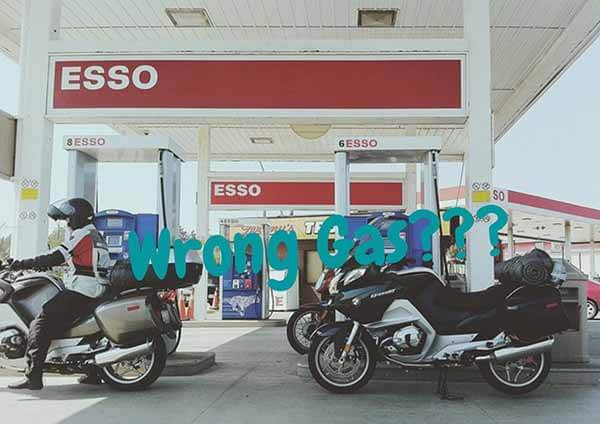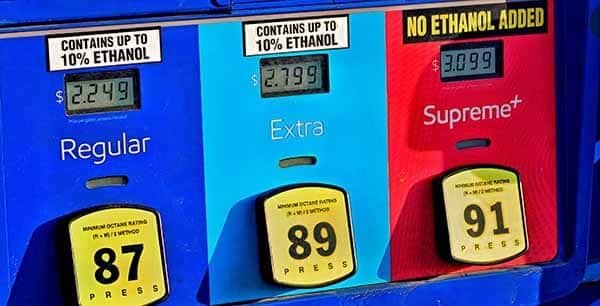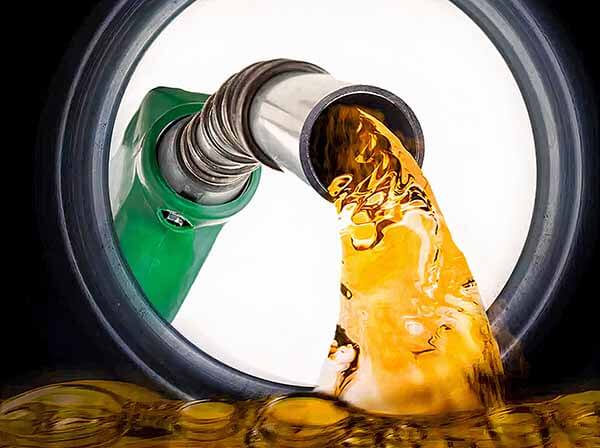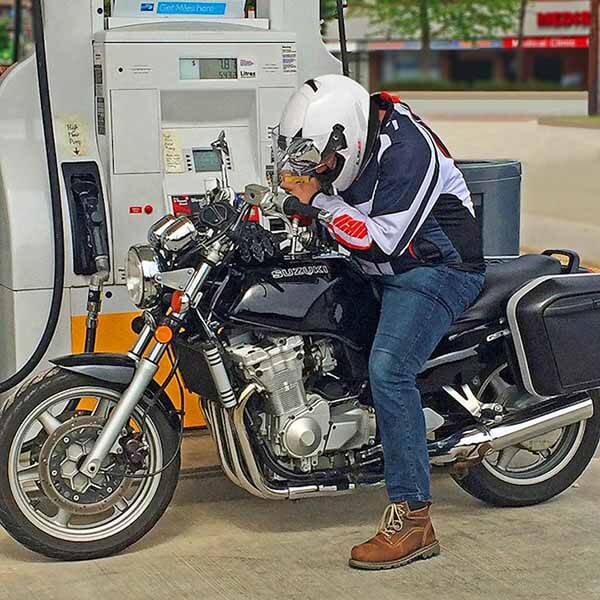You may have accidentally filled up your tank with the wrong gas if you misread the type of fuel at the pump or let another person fill up your bike. It could happen to the best of us, but what are the real consequences? Is it too late to save your adventure bike, or is there a way to fix a fueling error like this?
Incorrectly filled bikes may knock, smoke excessively, or suffer internal damage depending on the engine and the gas used. But it’s not the end of the world if you by chance fill up your bike with the wrong fuel (and you’re not alone). Consider what will happen in various situations and how you can respond as well as the best gas to use on your adventure bike.
The Right Kind of Gas an Adventure Motorcycle Needs
Oil corporations add several additives to gasoline, which is supposed to help us in the long term. However, such compounds might occasionally have harmful consequences for motorcycle engines. It’s critical that you understand exactly what you’re putting into your two-wheeler so that you can take better care of it, and it will take better care of you.
Ethanol-free higher-octane fuel (no less than a 90 rating) is recommended for adventure motorcycles. ADVs feature high compression engines, which necessitate a high-octane fuel. Ethanol is a gas additive that is intended to increase octane, but it can be dangerous in the long run, as you’ll see below.
It’s vital to know what fuel your bike needs before you buy one. This information is usually printed on the fuel tank of many models. For example, at the gas station, you may be provided with multiple grades of motorcycle fuel:
- Regular has an octane rating, ranging from 85 to 88, with an average of 87. The 87-octane gasoline contains the right combination of N-heptane and Octane to burn effectively without detonating. The mixture is a mid-grade
- Plus (or Silver/Extra) has an octane rating of 88 to 90, with an average of 89.
- Premium (Supreme+) has an octane rating of 90+, with an average of 92. The 90+ octane gasoline is designed specifically for high-performance motorcycles. It’s what we call premium gasoline. The fuels with an octane rating of 90 or above are the best.
Most bikes can run on 87 or 89 octane gas, but many ADV riders prefer high-octane fuel (90+) because the four-strokes are high compression engines.
You May Also Like:
Top 10 Quietest Gas-Powered Motorcycles
Best 10 Gas Can for Motorcycle And 5 Carriers to Hold It
What Happens If I Mistakenly Put Incorrect Gas in My Adventure Bike?
Effects of Ethanol in Fuel for Adventure Bikes
About 90% of oil refineries add ethanol to the gas. That’s why there’s a warning label on the pump that says, “May Contain Up To 10% Ethanol.” Ethanol is a sort of hydrocarbon that’s used to raise octane levels to comply with regulatory requirements on gas emissions. The catalytic action of ethanol on octane aids in its combustion efficiency. Lower-octane fuels won’t burn as well as higher-octane fuels, and they’ll emit more harmful pollutants.
Ethanol, on the other hand, may clog adventure-carbureted bikes like the Royal Enfield Himalayan. It may gum up a lot faster in small, tight locations like your carburetor than gas that doesn’t include ethanol. Fuel-injected motorcycles (of which there are a few examples below 500cc) are less likely to gum up than carbureted motorcycles. However, you need still be cautious about the gas you use because most modern adventure bikes are fuel injected and have a high compression ratio. When you have a high compression ratio, you should use premium, non-ethanol gasoline.
Furthermore, using ethanol in 2-stroke motorcycles (dirt bikes) is dangerous. The higher ethanol concentrations will break down the oil in your gasoline, meaning the bike won’t get enough lubrication, which can lead to engine damage.
Ethanol is relatively safer on 4-stroke bike engines. Fuel is not mixed with oil in 4-stroke bikes. So, the ethanol can’t break down the oil. Your bike has an oil reservoir and can run on ethanol-based fuels.
However, avoiding ethanol-based fuels, in general, can help prevent corrosion and clog ups, whether it be carbureted, fuel-injected, 2-stroke, or 4-stroke bikes. If you must use ethanol, use it sparingly (10% or less) and avoid making it a habit.
Ethanol-free gas is a little more expensive because it has a higher value product that goes into it.
What Is Octane and Why Is it Important?
Now that we’ve spoken about the best sort of petrol for your adventure motorcycle, you might be asking about the octane rating and why it’s so crucial when choosing your gasoline.
The performance of a particular type of gasoline is measured in octane. It’s the number that appears on the gas pump buttons, such as 83, 85, 91, and so on. You’ll notice various figures during different seasons. You may not have as many high-octane gasoline options in the winter. The proportion of octane in a mixture affects the quantity of octane in that combination.
You should also be aware that the octane rating has no bearing on the horsepower, torque, or fuel efficiency of your motorcycle. Rather, octane aids the performance of the engine and the fuel’s resistance to knocking. Because adventure bikes have high compression engines, high octane fuel is essential. The manufacturer’s recommended amount is sufficient but going over it isn’t wrong: your bike will merely keep its capabilities. However, do not use fuel with an octane rating lower than that of your motorcycle. As you will see later, this is really significant.
Motorcycle knocking usually occurs while you are riding your ADV and reach a high RPM, at which point you hear your bike banging. That’s the sound of the piston contacting a valve or the engine’s bottom skirt against the cylinder wall. A higher-octane fuel will be more resistant to knocking than a lower octane fuel. That means you won’t have to worry about your adventure bike detonating once it reaches high pressures and temperatures.
Misfuelling an Adventure Bike
Adventure bikes run on a four-stroke engine, which reacts slower to fuel changes than two strokes (dirt bikes).
So, assume you just filled up your adventure and realized you put in the wrong octane grade. What happens if you ride it now? It all depends on the fuel your bike was designed to run on and the fuel you actually added.
Example situations:
An Adventure Bike Requiring Premium Gas Filled with Regular or Mid-Grade Gas
When a four-stroke bike engine built for premium fuel (91-94 octane) is accidentally filled with regular or mid-grade fuel (87 octanes) or higher, there should be no significant consequences as long as you don’t hear any knocking or pinging from the engine while riding. While you may notice a slight loss in power/performance, your bike will still run on this fuel.
However, using an octane fuel lower than 90 in a two-stroke engine can cause engine knocking. This happens when the fuel in the engine burns earlier than it should, causing a knocking sound. Knocking can damage engine internals over time, so don’t ride if your bike is knocking. On a hot day, the engine makes a loud knocking noise (such as accelerating up a steep grade).
An Adventure Bike Made for a Lower Octane Fuel Filled with a Higher-Octane Fuel
Using high octane fuel like premium in a bike designed to run on lower octane fuel isn’t harmful to its internals. Your bike will run fine, if not better. Worst case scenario, you wasted money on fuel your bike didn’t need. If your bike is designed to run on 87 octanes, you can pay the extra money and get better performance.
High-octane fuel is not necessarily more efficient! Using the appropriate fuel type for your motorcycle will help it perform optimally and save you money.
Fuel the octane rating specified in your bike’s owner’s manual. The specs can also be found online. Use the special vehicle identification number (VIN) to find information on your bike just in case you don’t have the owner’s manual. To do this, simply search the 17-digit identifier or key it in on resource sites like Vinvaquero.com
Mixing Unleaded and Premium Gas in Your Adventure Bike
Unless your bike is designed for only high-octane fuel, it’s safe to use a mixture of unleaded and premium fuel. The latter tends to contain fewer chemicals compared to other blends like leaded fuel. It also increases engine performance.
If you don’t have access to mid-grade gas, you can mix unleaded and premium gas together to make your own custom fuel blend. Pure premium fuel may not always be worth the extra cost. Mid-grade results from mixing unleaded and premium fuel. It’s a bit cheaper than premium fuel and will slightly reduce the likelihood of knocking.
Contrarily, most gas stations sell mid-grade gas at a reasonable price, so mixing mid-grade and regular unleaded gas is not necessary. In terms of cost and performance, the act doesn’t make much sense. But it doesn’t damage your bike, either.
Putting Mixed Gas (Oil & Gas) in Your Adventure Bike
Four-stroke adventure motorcycles have an oil system that delivers lubricant to the piston and other critical areas. They don’t require a specific oil and fuel premix to work properly, unlike 2-stroke dirt bikes that rely on the oil being premixed with gas before use. This extra oil keeps the engine lubricated.
To lubricate a two-stroke bike engine, owners typically buy oil and fuel separately and mix them in a ratio of 32:1 to 40:1 (fuel to oil ratio). If a 2-stroke is only run on gasoline, it will overheat and seize due to lack of lubrication.
Refueling a 4-stroke with mixed fuel results in long-term damage. The bike may also smoke and perform poorly. This can cause greasy buildup inside the engine and damage the cylinder, piston, and other components, resulting in a loss of compression and ultimately complete engine failure.
Stop the bike and let the engine cool if you spot the mistake early enough. Remove the gas tank from the unit and pour all the tainted fuel out if possible.
Accidently Putting Oil in Your Adventure Bike’s Gas Tank
Pouring a large amount of oil into your gas tank may block the injectors, contaminate engine sensors, and harm the fuel pump. If enough oil gets into the gasoline, the engine will stop, and you’ll have to completely clean the fuel system as well as replace items like sensors, catalytic converters (which are expensive), and other components to get it functioning again.
If it’s a small amount, you can try to mix it up, but it’s best to drain the tank and refill it with the right fuel. The severity depends on the amount you poured in.
Mistakenly Putting Diesel in Your Adventure Bike
Although the military custom Kawasaki KLR650 and the now discontinued Royal Enfield Bullet Taurus, the first mass-produced diesel motorcycle, run on diesel, putting diesel in your bike is a bad idea. Diesel is made for a different kind of engine than gas.
Diesel in a gas motorcycle may not start, or if it does, it will smoke heavily and lose power quickly. It can even stall or throw flames from the exhaust pipe, causing serious injury or even a brush fire! If you accidentally put diesel in your gas bike, shut it down and drain the fuel. It’s risky to ride the two-wheeler or to try to burn off the fuel.
Not Using Your Adventure Bike After Fueling
So, how long does it take for the gas to become bad? You might be wondering! In around 30 days, unstabilized gas in a motorcycle will start to go bad. The chemistry of gas alters with contact with oxygen, which can rise to varnish and gum coatings. If the gas has been sitting for more than 6 months, it should not be used.
Final Thoughts: What Fuel Type Should Your Adventure Bike Use?
Unless you ride one of those fancy electric bikes, all our bikes require fuel to run properly. Contrary to popular belief, octane ratings and fuel blends are not complicated.
Adventure motorcycles need to use ethanol-free higher-octane gasoline. For better performance, use higher octane (90+) fuel, but avoid less. Prevent engine knocking and a bad day caused by a damaged engine. Maintain a consistent fuel type for your bike.
You can still ride your bike safely if you accidentally put in higher octane-rated gas than the recommended. Money spent on high-end fuel won’t hurt your engine. In fact, it may improve performance and prevent engine knocking.
But if you find yourself riding an adventure bike with low octane gas, as long as the engine doesn’t knock, it’s usually safe to keep going. If you want to avoid knocking, don’t try to run fast or through rough terrain on lower-octane gas.
The wrong fuel (diesel, oil, mixed gas, etc.) can be drained and refilled if you catch it before it causes internal damage to the bike. Relax, take a deep breath, and solve this! Aside from that, don’t beat yourself up too much for not paying attention while filling up.
Information for this article was partially sourced and researched from the following authoritative Government, educational, corporate, and nonprofit organizations:
Light Duty Vehicle, Short Wheelbase and Motorcycle Fuel Consumption and Travel (metric)
About the Author:
Michael Parrotte started his career in the motorcycle industry by importing AGV Helmets into the North American market. He was then appointed the Vice President of AGV Helmets America, total he worked with AGV Helmets for 25 years. In addition, he functioned as a consultant for KBC Helmets, Vemar Helmets, Suomy Helmets, Marushin Helmets, KYT Helmets, and Sparx Helmets.
In 1985, He is the Founder of AGV Sports Group, Inc. cooperation with AGV Helmets in Valenza Italy
Click here for LinkedIn Profile: https://www.linkedin.com/in/parrotte/
Click here for complete AGV Helmet & AGVSPORT History https://agvsport.com/michael-parrotte
Click here for all AGV Sports Group Social Media information http://agvsport.info/
FM/A




